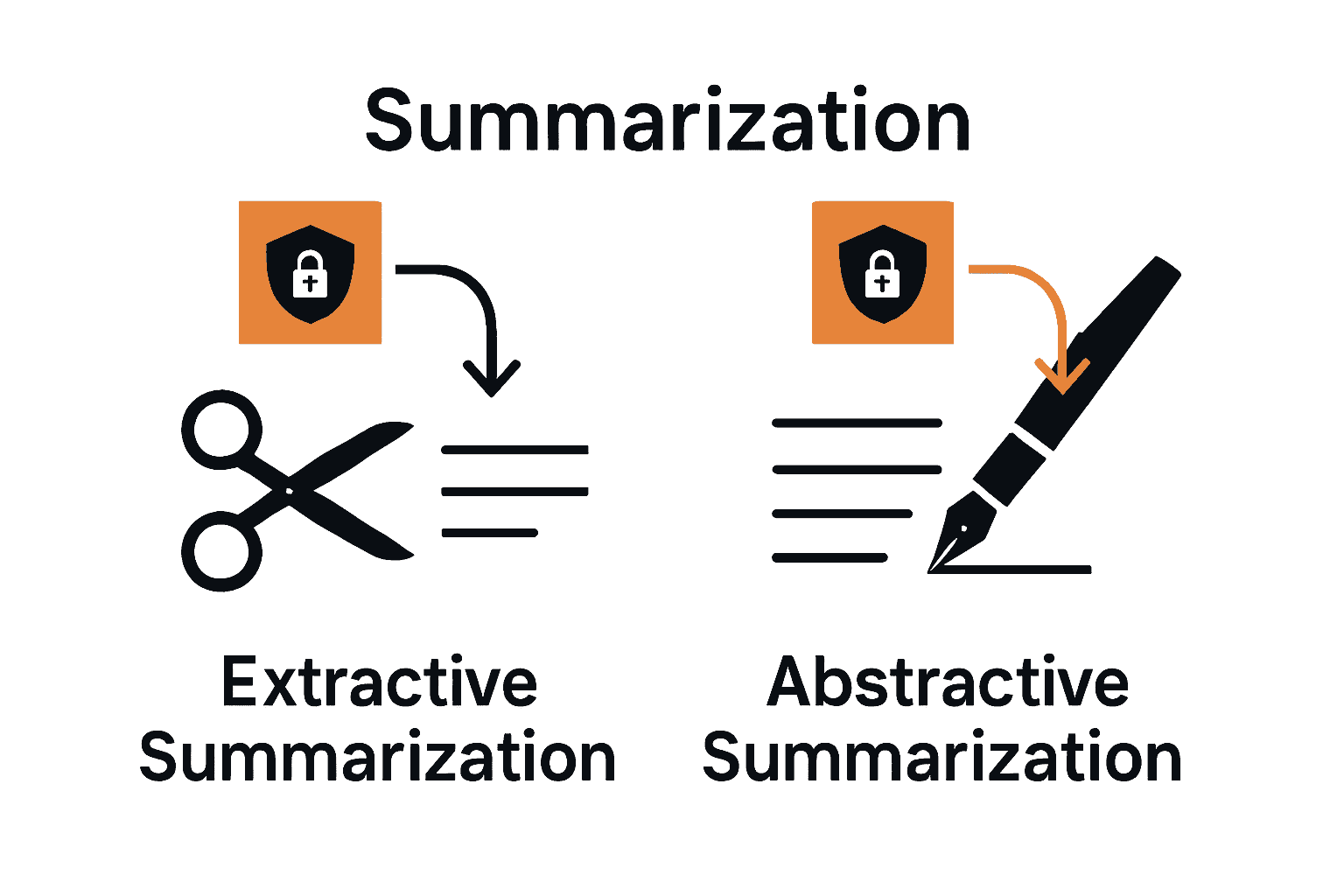Privacy in AI Summarization: Complete Guide

Every time AI distills information into bite-sized summaries, questions about personal data protection loom large. With over 60 percent of digital consumers expressing concerns about privacy in AI applications, the stakes have never been higher. As AI summarization becomes more widespread, understanding how these systems handle sensitive content shapes both trust and user safety. This article cuts through the jargon to reveal what privacy really means in the world of AI-powered summaries and why it matters for everyone.
Table of Contents
- Defining Privacy In AI Summarization
- AI Summarization Methods And Data Usage
- Key Privacy Risks And Data Exposures
- Legal Regulations And Global Frameworks
- Safeguarding Your Data During Summarization
Key Takeaways
| Point | Details |
|---|---|
| Privacy Considerations | AI summarization must protect personally identifiable information and maintain context, ensuring user consent and robust anonymization. |
| AI Summarization Methods | Key techniques include extractive and abstractive summarization, with neural attention models significantly enhancing the understanding of context. |
| Privacy Risks | Unintentional disclosures, algorithmic biases, and unauthorized data retention highlight the need for careful data handling in AI systems. |
| Legal Compliance | Organizations must align with global regulations like GDPR while balancing innovation with privacy rights and user expectations. |
Defining Privacy in AI Summarization
Privacy in AI summarization represents a complex intersection between technological innovation and personal information protection. At its core, this concept addresses how artificial intelligence systems handle, process, and represent sensitive content while maintaining individual privacy standards.
According to Wikipedia, the contextual integrity framework developed by Helen Nissenbaum provides critical insights into understanding privacy dynamics. This theory emphasizes that privacy isn’t just about restricting information access, but ensuring appropriate information flows that respect specific contextual norms. For AI summarization, this means generating summaries that protect original context and individual data boundaries.
Key privacy considerations in AI summarization include:
- Protecting personal identifiable information
- Maintaining original content context
- Ensuring user consent for data processing
- Implementing robust anonymization techniques
- Preventing unintended information disclosure
Computational linguist Ani Nenkova highlights that effective AI summarization requires sophisticated algorithms capable of understanding nuanced content boundaries. Her research underscores the importance of developing systems that can extract meaningful insights while meticulously protecting individual privacy rights.

Ultimately, privacy in AI summarization isn’t just a technical challenge – it’s a fundamental ethical responsibility. By prioritizing user trust and implementing rigorous privacy protocols, AI summarization tools can transform how we consume and interact with information safely and transparently. Learn more about AI summarization advantages to understand how these technologies balance innovation with individual privacy protection.
AI Summarization Methods and Data Usage
AI summarization represents a sophisticated technological approach that transforms how we process and extract essential information from large volumes of content. These methods leverage advanced algorithms and machine learning techniques to distill complex documents into concise, meaningful summaries.
Arxiv research reveals an innovative divide-and-conquer approach to document summarization, which breaks down extensive documents into smaller, more manageable tasks. This method significantly reduces computational complexity while creating more training opportunities for AI systems. By decomposing large documents, AI can more efficiently analyze and synthesize information without overwhelming processing requirements.
Key AI summarization methods include:
- Extractive summarization (selecting key sentences)
- Abstractive summarization (generating new sentences)
- Neural attention models
- Transformer-based approaches
- Semantic content mapping
According to another Arxiv study, neural attention models represent a cutting-edge data-driven technique. These models utilize local attention mechanisms to generate summaries conditioned on input sentences, demonstrating how AI can intelligently process and reconstruct information. By understanding contextual relationships, these systems can produce summaries that capture not just individual words, but the broader meaning and intent of the original content.
While these technologies offer immense potential, responsible data usage remains paramount. Understanding why choose AI summarizers can help users appreciate both the technological capabilities and ethical considerations inherent in these powerful tools. Privacy, consent, and transparent data handling are critical factors that must guide the development and deployment of AI summarization technologies.

Key Privacy Risks and Data Exposures
AI summarization technologies, while powerful, introduce significant privacy risks that users and developers must carefully navigate. These risks stem from the complex interactions between AI systems, user data, and the inherent challenges of processing sensitive information.
Arxiv research exploring human-AI interactions in text summarization reveals critical design considerations related to privacy and trust. The study highlights how interactions between humans and AI can inadvertently expose sensitive information, creating potential vulnerabilities in data handling and processing.
Primary privacy risks in AI summarization include:
- Unintentional personal information disclosure
- Algorithmic bias in data selection
- Potential re-identification of anonymized content
- Unauthorized data retention
- Lack of transparent consent mechanisms
- Cross-context information leakage
Another Arxiv study underscores the critical need for careful oversight in AI-generated content. Human-AI collaboration in summarization processes can create unexpected privacy vulnerabilities, especially when post-editing and content reconstruction occur.
This research emphasizes that privacy protection isn’t just about preventing direct data exposure, but also managing the nuanced ways AI systems might inadvertently reconstruct or recontextualize sensitive information.
Addressing these risks requires a proactive, multi-layered approach. 8 Examples of AI Summarization Tools You Need to Try can help users understand how different platforms approach privacy challenges. Ultimately, responsible AI summarization demands ongoing vigilance, robust anonymization techniques, and a commitment to user privacy that goes beyond mere technical compliance.
Legal Regulations and Global Frameworks
The landscape of legal regulations surrounding AI summarization represents a complex and evolving global challenge, requiring nuanced understanding of privacy, data protection, and technological innovation. As AI technologies continue to advance, legal frameworks must adapt to protect individual rights while enabling technological progress.
Wikipedia highlights the contextual integrity framework, which provides critical insights into understanding privacy regulations. This approach emphasizes that legal compliance isn’t just about restricting data access, but ensuring information flows align with appropriate contextual norms and user expectations.
Key global legal considerations include:
- General Data Protection Regulation (GDPR) compliance
- Consent and transparency requirements
- Right to data erasure and modification
- Cross-border data transfer restrictions
- Algorithmic accountability
- Mandatory privacy impact assessments
- User rights to understand AI decision-making processes
Computational linguist Ani Nenkova’s research underscores the complexity of developing AI systems that can simultaneously meet technological objectives and legal requirements. Her work demonstrates that effective AI summarization must balance sophisticated information processing with rigorous privacy protections.
Navigating these regulatory challenges requires continuous adaptation and proactive compliance strategies. Understanding the Advantages of AI Summaries can help users and developers appreciate the delicate balance between technological innovation and legal compliance. As global frameworks evolve, organizations must remain agile, prioritizing user privacy while leveraging the transformative potential of AI summarization technologies.
Safeguarding Your Data During Summarization
Protecting personal and sensitive information during the AI summarization process requires a comprehensive and proactive approach. Users and developers must implement strategic safeguards to prevent unauthorized data exposure and maintain robust privacy standards.
Arxiv research exploring human-AI interactions reveals critical design considerations for text summarization privacy. The study emphasizes the importance of creating interaction frameworks that prioritize data protection, highlighting how human oversight can significantly mitigate potential privacy risks during the summarization process.
Key data safeguarding strategies include:
- Implementing end-to-end encryption
- Utilizing anonymization techniques
- Establishing strict access controls
- Conducting regular privacy impact assessments
- Providing transparent user consent mechanisms
- Enabling granular data deletion options
- Minimizing data retention periods
Another Arxiv study underscores the critical role of human oversight in protecting data privacy during AI-generated summaries. This research demonstrates that effective safeguarding isn’t just about technological solutions, but requires active human intervention and continuous monitoring of AI summarization processes.
Navigating these complex privacy challenges demands ongoing vigilance and adaptive strategies. What Is Summary Generation? Complete Guide Explained can help users understand the intricate balance between technological innovation and data protection. By prioritizing user privacy and implementing robust safeguarding mechanisms, organizations can build trust and ensure responsible AI summarization practices.
Protect Your Privacy While Saving Time with AI Video Summaries
The challenge of maintaining privacy in AI summarization is real and important. As the article points out, protecting personal information and ensuring transparent data handling are key concerns when using AI to digest complex content. If you want to gain quick insights from videos without worrying about data exposure or lengthy viewing, SummYT offers a smart solution that respects your privacy while helping you learn faster.

Experience the power of AI summarization designed with privacy and efficiency in mind. SummYT helps students, professionals, and lifelong learners get clear, concise summaries from any YouTube video while implementing robust safeguards. Ready to keep your data safe and save hours of your valuable time? Start using SummYT today. Learn how AI can protect your information by exploring What Is Summary Generation? Complete Guide Explained and discover advantages of AI summarizers that bring privacy and productivity together.
Frequently Asked Questions
What is privacy in AI summarization?
Privacy in AI summarization refers to how artificial intelligence systems handle, process, and represent sensitive content while maintaining individual privacy standards, ensuring appropriate information flows that respect contextual norms.
What are the key privacy risks associated with AI summarization?
Key privacy risks include unintentional personal information disclosure, algorithmic bias, potential re-identification of anonymized content, unauthorized data retention, and cross-context information leakage.
What strategies can be implemented to safeguard data during AI summarization?
To safeguard data during AI summarization, strategies include implementing end-to-end encryption, utilizing anonymization techniques, establishing strict access controls, conducting regular privacy impact assessments, and providing transparent user consent mechanisms.
How do legal regulations impact AI summarization practices?
Legal regulations impact AI summarization by requiring compliance with frameworks like the GDPR, which emphasizes consent, transparency, algorithmic accountability, and user rights, ensuring data protection while allowing technological innovation.




